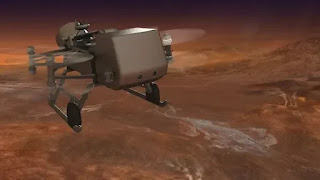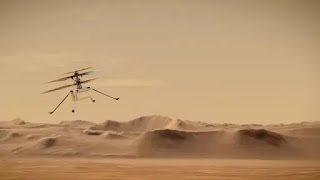The aeroplane that will noway fly!
On April 19 last time, a small experimental copter called Ingenuity flew over the face of Mars and saved itself in the history books.
This automatic machine rotated its rotors veritably presto to fly in the thick atmosphere of Mars and flew to a height equal to one storey structure.
After a short stay in space, Ingenotie returned safely to the face of Mars.
It was the first man- made flight to another earth after Earth.
The face on which Ingenotti landed on Mars has been named after the aeronautics precursor, the Wright Sisters. But the first mortal charge will begin.
Dragonfly will record further breakouts per hour than a rover flying over Mars.
The drone-like flying goblet with multiple rotors will land on the face of Titan for one Titan day ( original to 16 days of Earth) and also do to its coming destination.
So far no lander has been suitable to stay on the smooth but broken face of Venus for further than 127 twinkles. Still, scientists are proposing to shoot two vessels to Venus.
A small copter like the Anguity ( right) is a much easier way to observe the atmosphere of other globes.
One is an air- glided spacecraft that's powered by solar energy and always flies in the upper atmosphere of the earth which is more favorable, and the other is a winged aircraft that can fly in the harsh and inimical atmosphere of Venus.
Dr. Elder Nove Dobria, a elderly scientist at the Planetary Science Institute in California who's developing the general conception of Venus's charge, says that it's veritably delicate to develop a technology that can land on Venus.
Robot technologist Teddy Zenitos was part of the upstanding mobility group that developed the flying machine on Mars, and is now working on the design of the coming- generation copter on Mars.
"We know what the first flight of the Wright Sisters did to humanity, and we will use the same model for other globes," said Teddy Zenitos.
"I noway allowed of comparisons, but Dragon Fly is the coming step in the first flight of the Imagination," said Elizabeth Turtle, top investigator at Johns Hopkins Applied Physics Laboratory.
It'll be the first aeroplane to carry all scientific outfit."
NASA masterminds, like those who introduced polar aeronautics, realized that space- flying machines could be important in exploring these unseen corridor of the macrocosm.
Popular wharf machines on Mars, similar as Viking and Curiosity, and Titan's Cassini in its route will continue to play a crucial part in the hunt for a more environmentally friendly terrain, but there are other options as well.
Robots and controlled copters, drones and other aircraft that can be filled with air (these are all suggestions from NASA scientists) and they can snappily collect data about utmost of the earth, dangerous Cover themselves from shells, recoup footage that can not be recaptured from route or rover, and be suitable to examine charge targets from angles.
Flying vehicles can go where rovers can't, ie mountains, peaks and indeed on the hard face of Venus.
The problem for NASA masterminds is that each earth has a different atmosphere and this can beget the aircraft to face different difficulties, depending on its cargo and capabilities. Masterminds also have enterprises about technology.
Saturn V rocket developer Werner von Brown imagined wharf on Mars in a hypersonic glider.
Science fabrication pen PhilipK. Dick imagined mortal colonies on Mars in copters. NASA masterminds began looking at generalities of aeroplanes on Mars after the Viking landers in the 1970s, some of which can be seen in moment's Bloodsucker drones used by the US service.
On Mars, the atmosphere is lower than one percent thick than on Earth, making it veritably delicate for aircraft to produce elevators.
This means that the Mars copter should be veritably light, but still able of carrying its lithium-ion batteries, detectors and cameras, as well as heating and sequestration on the cold nights of Mars so that He could be kept alive.
If you can break all these challenges and make an aircraft that weighs lower than1.8 kg, also you have your own engineering,"says Zenitos.
"
Our principal mastermind and platoon members first started allowing about Mars copters in the 1990's, but also there was no technology,"he says. Fast forward to the 2010s for technology demonstrators.
A small nuclear reactor could power a helicopter like the Dragonfly.
The platoon also considered a fixed- sect aircraft, but the helicopter on Mars looked much better because it had to operate without an airport.
NASA has nine different Technology Readiness Situations (TRLs) ranging from TRL 1, where' introductory principles are observed and reported'to'TRL 9'which means Flight has been proven through charge operations.
The types of batteries demanded to power machines in the 1990's have only lately been developed, and many people have an idea of the eventuality of accoutrements similar as carbon fiber.
Also, the detectors weren't good enough to blow up the machine. Nor did they've the mortal skill to make and fly.
Further than 20 times latterly, this is a different matter. Moment, drones deliver parcels and vaccines on the ground and are used to survey crops and archeological spots"It was the perfect time for all the technologies that enabled engineering,"says Zenitos.
Imagination has completed its test breakouts and is still flying."The thing was to prove that we can fly to Mars, and we have done that in further than 30 breakouts,"says Zenitos.





